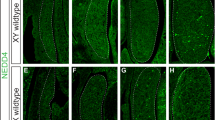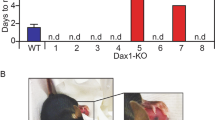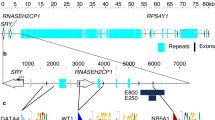Abstract
DAX1, which encodes an unusual member of the nuclear hormone-receptor superfamily, is a gene that may be responsible for a sex-reversal syndrome in humans, referred to as dosage-sensitive sex reversal, in which XY individuals carrying duplications of Xp21, part of the small arm of the X chromosome, develop as females. XY mice carrying extra copies of mouse Dax1 as a transgene show delayed testis development when the gene is expressed at high levels, but do not normally show sex reversal. Complete sex reversal occurs, however, when the transgene is tested against weak alleles of the sex-determining Y-chromosome gene Sry. These results show that DAX1 is largely, if not solely, responsible for dosage-sensitive sex reversal and provide a model for early events in mammalian sex determination, when precise levels and timing of gene expression are critical.
This is a preview of subscription content, access via your institution
Access options
Subscribe to this journal
Receive 51 print issues and online access
$199.00 per year
only $3.90 per issue
Buy this article
- Purchase on Springer Link
- Instant access to full article PDF
Prices may be subject to local taxes which are calculated during checkout







Similar content being viewed by others
References
Gubbay, J. et al. Agene mapping ot the sex determining region of the mouse Y chromosome is a member of a novel family of embryonically expressed genes. Nature 346, 245–250 (1990).
Sinclair, A. H. et al. Agene from the human sex-determining region encodes a protein with homology to a conserved DNA-binding motif. Nature 346, 240–244 (1990).
Koopman, P. et al. Male development of chromsomally female mice transgenic for Sry. Nature 351, 117–121 (1991).
Hacker, A., Capel, B., Goodfellow, P. & Lovell-Badge, R. Expression of Sry, the mouse sex determining gene. Development 121, 1603–1614 (1995).
Jeske, Y. W., Bowles, J., Greenfield, A. & Koopman, P. Expression of a linear Sry transcript in the mouse genital ridge. Nature Genet. 10, 480–482 (1995).
Palmer, S. & Burgoyne, P. S. In situ analysis of fetal, prepuberal and adult XX-XY chimaeric mouse testes: Sertoli cells are predominantly, but not exclusively, XY. Development 112, 265–268 (1991).
McLaren, A. Development of the mammalian gonad: the fate of the supporting cell lineage. BioEssays 13, 151–156 (1991).
Harley, V. R. et al. DNA binding activity of recombinant SRY from normal males and XY females. Science 255, 453–456 (1992).
Hawkins, J. R. Sex determination. Hum. Mol. Genet. 3, 1463–1467 (1994).
Whitfield, S., Lovell-Badge, R. & Goodfellow, P. N. Rapid sequence evolution of the sex determining gene SRY. Nature 364, 713–715 (1993).
Tucker, P. K. & Lundrigan, B. L. Rapid evolution of the sex determining locus in Old World mice and rats. Nature 364, 715–717 (1993).
Pontiggia, A. et al. Sex-reversing mutations affect the architecture of SRY-DNA complexes. EMBO J. 13, 5115–6124 (1994).
Capel, B. & Lovell-Badge, R. in Advances in Developmental Biology Vol. 2 (ed. P. Wassarman) 1–35 (JAI, (1993).
da Silva, S. et al. Sox9 expression during gonadal development implies a conserved role for the gene in testis differentiation in mammals and birds. Nature Genet. 14, 62–68 (1996).
Kent, J. et al. Amale-specific role for Sox9 in vertebrate sex determination. Development 122, 2813–2822 (1996).
Bardoni, B. et al. Adosage sensitive locus at chromosome Xp21 is involved in male to female sex reversal. Nature Genet. 7, 497–501 (1994).
Dabovic, B. et al. Afamily of rapidly evolving genes from the sex reversal critical region in Xp21. Mamm. Genome 6, 571–580 (1995).
Zanaria, E. et al. An unusual member of the nuclear hormone receptor superfamily responsible for X-linked adrenal hypoplasia congenita. Nature 372, 635–641 (1994).
Muscatelli, F. et al. Mutations in the DAX-1 gene gives rise to both X-linked adrenal hypoplasia congenita and hypogonadotropic hypogonadism. Nature 372, 672–676 (1994).
Swain, A. et al. Mouse Dax-1 expression is consistent with a role in sex determination as well as in adrenal and hypothalamus function. Nature Genet. 12, 404–409 (1996).
Ikeda, Y. et al. Steroidegenic factor 1 and Dax-1 co-localize in multiple cell lineages: potential links in endocrine development. Mol. Endocrinol. 10, 1261–1272 (1996).
Guo, W., Burris, T. P. & McCabe, E. R. Expresison of Dax-1, the gene responsible for X-linked adrenal hypoplasia congenita and hypogonadotropic hypogonadism in the hypothalamic-pituitary-adrenal/gonadal axis. Biochem. Mol. Med. 56, 8–13 (1995).
Lovell-Badge, R. & Hacker, A. The molecular genetics of Sry and its role in mammalian sex determination. Phil. Trans. R. Soc. Lond. B 350, 205–214 (1995).
Munsterberg, A. & Lovell-Badge, R. Expression of the mouse anti-Mullerian hormone gene suggests a role in both male and female sexual differentiation. Development 113, 613–624 (1991).
Tamai, K. T. et al. Hormonal and developmental regulation of Dax1 expression in Sertoli cells. Mol. Endocrinol. 10, 1561–1569 (1996).
Smith, R. L., Geller, A. L., Escudero, K. W. & Wilcox, C. L. Long-term expression in sensory neurons in tissue culture of herpes simplex virus type1 (HSV-1) promoters in an HSV-1-derived vector. J. Virol. 69, 4593–4599 (1995).
Lovell-Badge, R. Transgenic Modification of Germline and Somatic Cells: Examples from Animals and Plants. Phil. Trans. R. Soc. Lond. B 339, 159–164 (1993).
Eicher, E. M., Shown, E. P. & Washburn, L. L. Sex reversal in C57BL/6J-YPOS mice corrected by a Sry transgene. Phil. Trans. R. Soc. Lond. B 350, 263–269 (1995).
Eicher, E. M., Washburn, L. L., Whitney, B. I & Morrow, K. E. Mus poschiavinus Y chromosome in the C57BL/6J murine genome causes sex reversal. Science 217, 535–537 (1982).
Palmer, S. J. & Burgoyne, P. S. The Mus musculus domesticus Tdy allele acts later than the Mus musculus musculus Tdy allele: a basis for XY sex-reversal in C57BL/6-YPOS mice. Development 113, 709–714 (1991).
Lovell-Badge, R. & Robertson, E. XY female mice resulting from a heritable mutation in the primary testis determining gene, Tdy. Development 109, 635–646 (1990).
Eicher, E. M. et al. Sex-determining genes on mouse autosomes identified by linkage analysis of C57BL/6-YPOS sex reversal. Nature Genet. 14, 206–209 (1996).
Capel, B. et al. Deletion of Y chromosome sequences located outside the testis determining region can cause XY female sex reversal. Nature Genet. 5, 301–307 (1993).
Clepet, C. et al. The human SRY transcript. Hum. Mol. Genet. 2, 2007–2012 (1993).
Dubin, R. A. & Ostrer, H. SRY is a transcriptional activator. Mol. Endocrinol. 8, 1182–1192 (1994).
Poulat, F. et al. The human testis determining factor SRY binds a nuclear factor containing PDZ protein interaction domains. J. Biol. Chem. 272, 7167–7172 (1997).
Coward, P. et al. Polymorphism of a CAG trinucleotide repeat within Sry correlates with B6 YDom sex reversal. Nature Genet. 6, 245–250 (1994).
Graves, J. A. M. The evolution of mammalian sex chromosomes and the origin of sex determining genes. Phil. Trans. R. Soc. Lond. B 350, 305–312 (1995).
Renfree, M., Harry, J. L. & Shaw, G. The marsupial male: a role model for sexual development. Phil. Trans. R. Soc. Lond. B 350, 243–251 (1995).
Pask, A. et al. The candidate sex-reversing DAX1 gene is autosomal in marsupials: implications for the evolution of sex determination in mammals. Genomics 41, 422–426 (1997).
Foster, J. W. Campomelic dysplasia and autosomal sex reversal caused by mutations in an SRY related gene. Nature 372, 525–530 (1994).
Wagner, T. et al. Autosomal sex reversal campomelic dysplasia are caused by mutations in and around the SRY related gene SOX9. Cell 79, 1111–1120 (1994).
Kwok, C. et al. Mutations in SOX9, the gene responsible for campomelic dysplasia and autosomal sex reversal. Am. J. Hum. Genet. 57, 1028–1036 (1995).
Ito, M., Yu, R. & Jameson, J. L. DAX-1 inhibits SF-1 mediated transactivation via a carboxy-terminal domain that is deleted in adrenal hypoplasia congenita. Mol. Cell. Biol. 17, 1476–1483 (1997).
Shen, W. et al. Nuclear receptor steroidogenic factor 1 regulates the mullerian inhibiting substance gene: a link to the sex determination cascade. Cell 77, 651–661 (1994).
Ikeda, Y. et al. Characterization of the mouse FTZ-F1 gene, which encodes a key regulator of steroid hybroxylase gene expression. Mol. Endrocrinol. 7, 852–860 (1993).
Honda, S.-I. et al. Ad4BP regulating steroidogenic P-450 gene is a member of steroid hormone receptor superfamily. J. Biol. Chem. 268, 7494–7502 (1993).
Ikeda, Y. et al. Steroidogenic factor 1 and Dax1 co-localize in multiple cell lineages: potential links in endocrine development. Mol. Endrocrinol. 10, 1261–1272 (1996).
Narvaez, V. Expression and regulation of sex determining genes in the mouse. Thesis, Univ. London, (1996).
Sham, M. H. et al. The zinc finger gene Krox20 regulates HoxB2 (Hox2.8) during hindbrain segmentation. Cell 72, 183–196 (1993).
Wilkinson, D. & Nieto, M. A. Guide to Techniques in Mouse Development. Methods Enzymol. 225, 361–372 (1993).
Acknowledgements
We thank members of R.L.B.'s laboratory and B. Capel for suggestions, P.Sassone-Corsi for anti-DAX1 antibody, E. Zanaria for genomic and cDNA probes, E. Grigorieva for help with histological analysis, K. Woolley and C. Wise for help with mouse genotyping, the animal caretakers at NIMR, and J. Brock for photography. The financial support from the MRC and Louis Jeantet Foundation (R.L.-B.), the DGAPA-UNAM, Mexico and the British Council (V.N.), and Telethon, Italy and the European Commission (G.C.) is gratefully acknowledged.
Author information
Authors and Affiliations
Rights and permissions
About this article
Cite this article
Swain, A., Narvaez, V., Burgoyne, P. et al. Dax1 antagonizes Sry action in mammalian sex determination. Nature 391, 761–767 (1998). https://doi.org/10.1038/35799
Received:
Accepted:
Issue Date:
DOI: https://doi.org/10.1038/35799
This article is cited by
-
SDX on the X chromosome is required for male sex determination
Cell Research (2022)
-
Sexual determination in zebrafish
Cellular and Molecular Life Sciences (2022)
-
Cloning, characterization and function analysis of DAX1 in Chinese loach (Paramisgurnus dabryanus)
Genetica (2018)
Comments
By submitting a comment you agree to abide by our Terms and Community Guidelines. If you find something abusive or that does not comply with our terms or guidelines please flag it as inappropriate.



